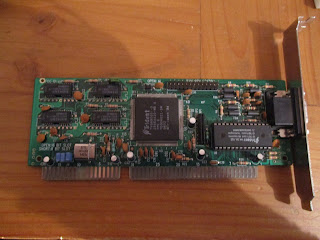Testing multiplexed LED display drive methods.
I have decided to start with 7 segment displays for my Z80 computer, a video display may come in a later version.
I remember Maplin used to sell the intel 8279 keyboard/display controller IC. This would solve many problems with the build, and surplus supplies are available from several Chinese ebay dealers.
So I ordered a couple (just in case!), and now only needed some displays.
I quick search on ebay found 4 of these for about £1 each.
But I would need a simple multiplexed display driver to test things with.
To make this I would need a clock of several kHz, a 2-bit binary counter, a 2 to 4 line decoder and some data to send to the display. To provide the drive current for the LED's I would try several different buffer/driver chips.
The clock comes from the 1kHz on my development board, I used a 74LS139 as the decoder and I found a ex-equipment 74S288 PROM with some random data to provide something to display. To make the 2 bit counter I used the 2 D-Flip-flops in a 74LS74.
So here is the circuit made up:
And, to my great surprise here it is powered up!
I remember Maplin used to sell the intel 8279 keyboard/display controller IC. This would solve many problems with the build, and surplus supplies are available from several Chinese ebay dealers.
So I ordered a couple (just in case!), and now only needed some displays.
I quick search on ebay found 4 of these for about £1 each.
You can see these have 4 digits (plus decimal point) making 32 segments. But they are connected through 12 pins. 4 of the pins connect to all the cathodes of a single digit, and the other 8 connect to all the anodes of one segment.
The data sheet for the 8279 has the LED driven using 16 transistors and 16 resistors for a 8 digit display. I wanted to see if there were better ways, maybe using TTL chips.
But I would need a simple multiplexed display driver to test things with.
To make this I would need a clock of several kHz, a 2-bit binary counter, a 2 to 4 line decoder and some data to send to the display. To provide the drive current for the LED's I would try several different buffer/driver chips.
The clock comes from the 1kHz on my development board, I used a 74LS139 as the decoder and I found a ex-equipment 74S288 PROM with some random data to provide something to display. To make the 2 bit counter I used the 2 D-Flip-flops in a 74LS74.
So here is the circuit made up:
And, to my great surprise here it is powered up!
I only made a couple of minor wiring errors, and I was quite surprised by how bright the display lit up. Since I am sinking through the LS139 the current will be limited, and I expected it to be quite dim. A good start.
More experimenting to follow.





Comments
Post a Comment